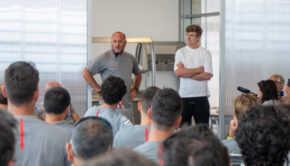Will virtual technology win the next America’s Cup?
Published on August 7th, 2014
While the sense of wind and spray on a sailboat can never be replaced, VIRTAC hopes their Virtual Reality technology will provide sailors with the ability to simulate sailing. Perhaps a handy tool during cold winter seasons, VIRTAC is betting their tools will be a valuable training asset for the next America’s Cup.
As the Protocol for the 2017 event seeks to reduce costs by limiting actual sailing time, virtual sailing might be the best alternative. Here they report on some of the issues the teams will be working on…
One of the most useful aspects of the VIRTAC simulator will be the capability for sailors to learn and practice the optimal strategies for foiling, both upwind and down. These are not as simple as they might first appear, particularly the upwind case.
During the 34th America’s Cup, held in San Francisco last year, the ability of the Oracle team to foil their AC72 upwind at key points in the later races proved to be an invaluable asset and a significant factor in their victory.
Since then, the AC62 class has been defined as a successor to the AC72, with foiling upwind in as little as 12 knots of wind mentioned as an objective. Whether this design goal is achievable and whether it will translate into consistent upwind foiling is another matter.
America’s Cup designers such as Pete Melvin and Paul Bieker have talked about making the AC62 foil in lower winds than was feasible with the AC72. However, when the dimensions for the AC62 are compared with a scaled down AC72, the boat is heavier relative to its righting moment and sail area. This does not indicate a boat that will be more likely to foil in light winds than the AC72.
It is possible that the teams may reduce aerodynamic drag on their AC62s even more than was achieved by the Oracle team with their Cup-winning boat, but paradoxically, this may not make upwind foiling more advantageous, as it would improve the lift/drag ratio of the boat and make the high, non-foiling mode even more efficient.
Unlike the AC72, the AC62 allows dynamic control of rudder foil angle of attack. As a result, it may be possible to improve the efficiency of the main foils of the AC62 as they will not need to be as self-regulating in the heave axis. This may deliver some gains in the upwind foiling mode, as side-force can be generated more effectively when flying height can be precisely controlled. But how much more efficient upwind foiling will become is unclear, and whether upwind foiling mode can improve on the VMG available in the high-pointing displacement mode is also uncertain.
Some America’s Cup designers now believe that hulls are simply “foil delivery systems” and that hull design is no longer important, but this may be a naive view. It is a safe bet that the AC62s will be able to foil upwind in most conditions, but it is far from guaranteed that they will do so the majority of the time while racing.








 We’ll keep your information safe.
We’ll keep your information safe.